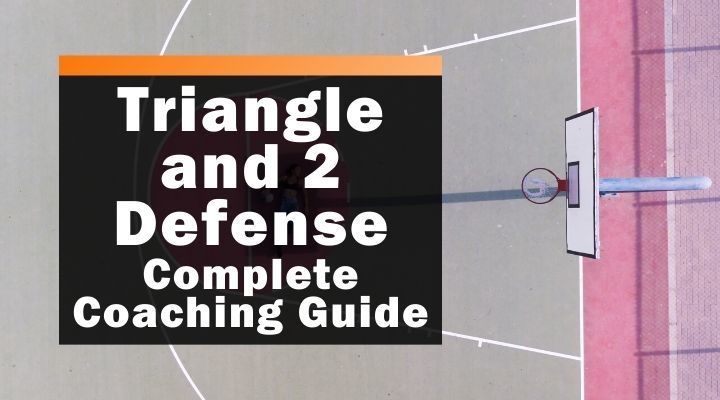
If you’re coaching against a team where two players do most of the scoring, it might be the perfect opportunity to implement the triangle and 2 defense.
The triangle and 2 defense is a “junk defense” that can give your team a unique option to stop an offense that revolves mostly around only two players.
Note: A ‘junk defense’ is a defense that combines man-to-man and zone principles together. The Box and 1 is another example.
The Triangle and 2 can be effective because it’s so rarely used and practiced against.
This can frustrate your opponent’s best players and force the other team to make offensive adjustments they’re not normally used to.
Strengths of the Triangle and 2 Defense
1. Easily Implemented
Although the Triangle and 2 may be something totally different from what your team is used to, it’s not overly complicated to implement this defense.
2. Gives Your Team Another Option
If you’re interested in implementing a new defense because your opponent centers their offense around two players, your obvious concern is that those two players could dominate against your typical defense.
Having the Triangle and 2 in your back pocket can be another option in case your primary defense is not producing the stops you need to win the game.
3. Frustrates the Other Team’s Stars
As mentioned earlier, one of the main reasons a Triangle and 2 defense can be effective is because it is so rarely used.
This means that it’s unlikely that your opponent has seen this defense before - or even if they have, they have probably not practiced extensively against it.
This inexperience can cause frustration for the other team, and specifically for the two stars that are being chased.
4. Fatigues their Two Best Players
Because your two chasers will be playing full denial defense, the other team’s two best scorers should have to work harder in order to get touches.
Not only will this frustrate them, but it will wear them down physically.
5. Forces Other Players to Shoot
If the Triangle and 2 defense is working correctly, it should encourage your opponent’s two best scorers to give up the ball, and force the other three players on the floor to make plays they’re not used to making.
Especially in bigger games, it’s less likely that the “role players” will feel comfortable stepping into a primary scoring role.
Weaknesses of the Triangle and 2 Defense
1. Middle of the Zone
Like most zones, the middle of the floor is where the Triangle and 2 defense will be the most vulnerable.
Defending the middle of the floor will primarily be up to the 3 players who are in the triangle zone formation.
We will talk more about individual responsibilities in the zone below.
2. Three-Point Shooters
If you’re playing against a team with multiple outside shooting threats (outside of the two top scorers that are being chased), the Triangle and 2 may not be your best option because you have limited players responsible for guarding the entire three-point line.
However, it’s unlikely that a team centered around only two scoring threats will also be littered with other great outside shooters.
3. Against Post Scorers
If one of the two scoring threats does most of their scoring in the post, then the Triangle and 2 may not be your best option.
It’s primarily effective against perimeter players who prefer to shoot from the outside or make plays off the drive.
If one of the players who is being chased is primarily posting up on the block, the lane can become too congested and you can end up with two of your defenders playing in the same spot.
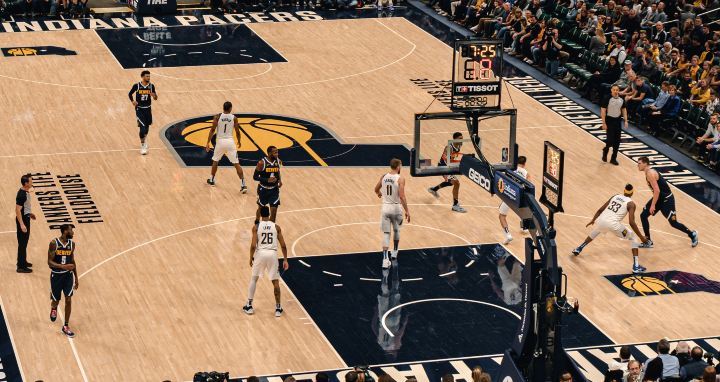
Triangle and 2 Defense Rules
1. Limit Touches for the 2 Star Players
The reason you’re running the Triangle and 2 defense is to limit opportunities for an offense that revolves around just two players.
Your two chasers must be in full denial defense, making it as difficult as possible for the player they’re guarding to get the ball.
The chasers don’t need to worry about anything besides denying touches for the player they’re defending, and they must trust their teammates to play help defense.
2. Limit Second Chance Points
Rebounding can be difficult in any zone, and the same goes for the Triangle and 2 defense.
After a shot goes up, one player should contest the shot, and at least three players should be working for the rebound.
3. Defense Collapses When Stars Get the Ball
Even though your chasers are playing full denial defense on the other team’s two best scorers, it’s inevitable that they will still get touches at some point.
When this happens, the triangle zone defenders must collapse back into their triangle positions so they’re in position to help on the scorers.
This should encourage the scorers to pass to a teammate because they do not have an open lane to the basket.
Roles and Responsibilities
When running the Triangle and 2 defense, there are 3 different positions that your defenders could play:
1. Chasers
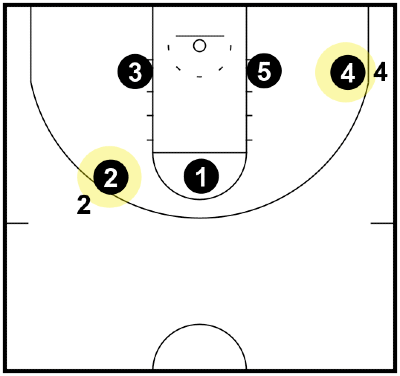
The success of your Triangle and 2 defense will largely depend on the ability of your chasers.
These are the two players you assign to the two primary scorers on the other team.
The chasers need to play full denial defense at all times.
The chasers are primarily focused on making everything as difficult as possible for the player they’re guarding. They’re not responsible for help defense or any other rotations.
One thing the chasers have to be very conscious of is staying out of foul trouble. Because they are playing full denial defense that’s designed to frustrate one of the other team’s best players, the chasers will have many opportunities to foul.
2. Bottom Triangle Defenders
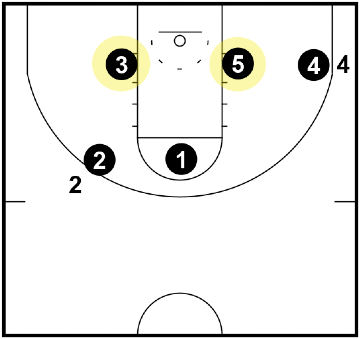
Ideally, two of your bigger players will be positioned as the bottom two defenders in the triangle zone formation.
They’re responsible for defending the low post (fronting if the ball is above the free throw line), guarding the ball when it is below the free throw line, and help defense on the weak side.
Like any zone, the Triangle and 2 defense can be susceptible to offensive rebounds, so your bottom triangle zone defenders must be solid rebounders who can limit your opponent’s second chance points.
3. Top Triangle Defender
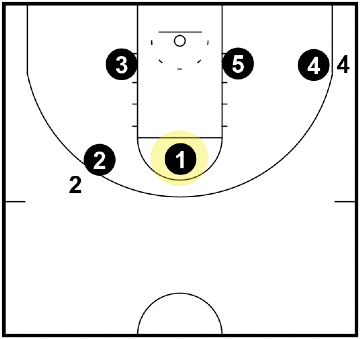
The best option for your top triangle zone defender is a quick player who is also a good on-ball defender, as they will be responsible for covering the biggest portion of the court.
The top triangle zone defender is responsible for denying touches to the high post, and also guarding the ball any time it is above the free throw line.
Situations and Rotations
Once you have assigned who will be your two chasers, your two bottom triangle zone defenders, and your one top triangle zone defender, you will need to establish each position’s responsibilities in different situations.
When a Star Player Has the Basketball:
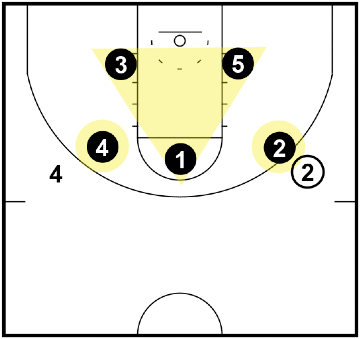
Even though your chasers are in full denial defense on the two best scorers, they will still end up getting the basketball at some stage.
When this happens, the three triangle zone defenders should immediately set up in their original triangle positions.
This will show the ball handler that your help defense is ready, and it should also leave other teammates open around the perimeter, which will hopefully encourage the star player to pass.
When the Ball is at the Top of the Key:
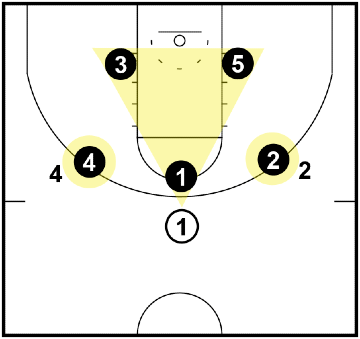
If the ball is at the top of the key, the top triangle zone defender should be between the ball handler and the offensive player in the high post.
They should not be applying over-the-top ball pressure.
After all, a “role player” shooting from the outside is a win for you.
Instead, the top triangle zone defender needs to be in position to guard the drive if the ball handler goes toward the lane, while also discouraging an entry pass to the high post.
The bottom triangle zone defenders should be fronting if there is a player in the low post, and the chasers are both playing full denial defense.
When the Ball is Above the FT Line on the Wing:
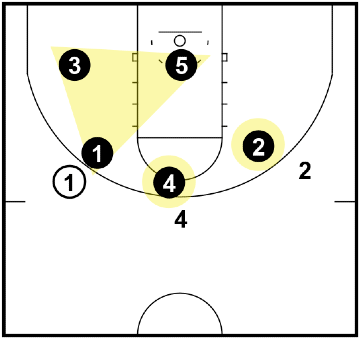
If the ball is passed to a player on the wing who is above the free throw line, the top triangle zone defender should be somewhere around the ball side elbow.
Just like when the ball was at the top of the key, the top triangle zone defender is not playing pressure defense against the ball, as he must also discourage the high post entry pass in addition to being able to guard the potential drive.
The bottom triangle zone defender who is on the ball side should be fronting the low post.
The bottom triangle zone defender who is on the weak side should be in the middle of the lane, ready to help against a potential drive or to close out on a skip pass.
Again, the chasers are both playing full denial defense.
When the Ball is Below the FT Line on the Wing:
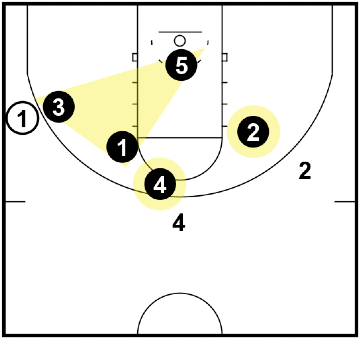
If the ball is passed to a player on the wing who is below the free throw line, the bottom triangle zone defender who is on the ball side should step out and guard the ball.
However, he should not be playing pressure defense on the ball. He needs to be able to guard against the drive, but also to discourage an easy entry into the low post.
The bottom triangle zone defender who is on the weak side should slide over to play defense behind the offensive player on the ball-side block.
Although you want your posts to front at other times in the Triangle and 2 defense, the weak side triangle zone defender still has to be able to close out to the other side of the court on a skip pass.
The top triangle zone defender should be just below the ball side elbow, ready to both help on the potential drive, or take away an entry pass into the high post or the lane.
Again, the chasers are both playing full denial defense.
When the Ball is in the Corner:
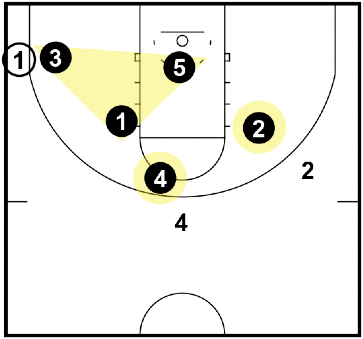
If the ball is passed to the corner, the bottom triangle zone defender on the ball side should again be in position to guard against the drive, but also be able to take away a post entry.
The bottom triangle zone defender on the weak side should again slide over to guard the post on the ball side block. He will have to play defense behind that post player so that he can still close out on a skip pass.
The top triangle zone defender should again be just below the ball side block, where he is able to both help against potential dribble penetration and take away an entry pass into the high post or the lane.
Again, the chasers are both playing full denial defense.
When the Ball is in the High Post:
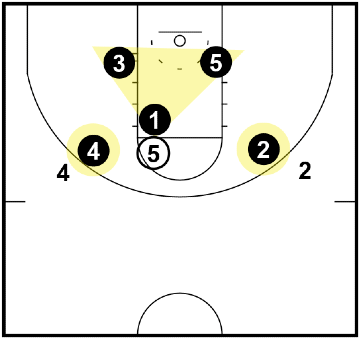
Even though your top triangle zone defender will be trying to take away entry passes into the high post, any good zone offense will eventually get the ball to the middle of the floor.
When this happens, the top triangle zone defender should guard the ball with intense ball pressure, trying to get them to pass the ball out.
The bottom triangle zone defenders should also be in their original triangle positions, ready to help against the potential drive and also deny entry passes into the low post.
They also need to be ready to close out and guard the ball if it is passed to the wing (below the free throw line) or the corner.
Again, the chasers are both playing full denial defense.
When the Ball is in the Low Post:
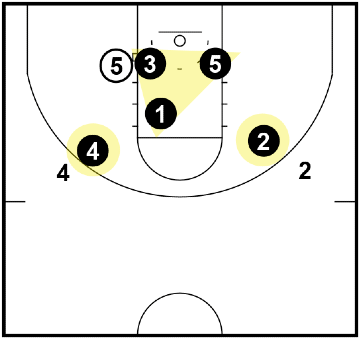
Your bottom triangle zone defenders should be working to deny post entry passes at all times.
However, if the ball does get passed into the low post while your defender is sealed, the bottom triangle zone defender should play straight up and try to contest a shot.
The top triangle zone defender should sink down and be ready to help, in case the bottom triangle zone defender is sealed.
Again, the chasers are both playing full denial defense.
Defending Skip Passes
Guarding skip passes in the Triangle and 2 defense should be relatively simple, as long as your players know their responsibilities in the situations above.
Wing to Corner
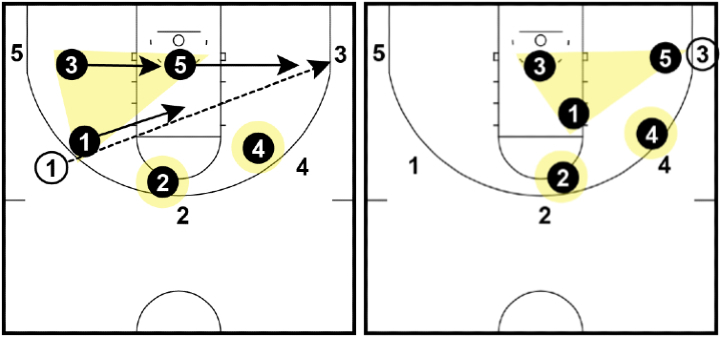
When the ball is on the wing, the bottom triangle zone defender on the weak side should be in the middle of the lane.
If the ball is then skipped from the wing to the opposite corner, the bottom triangle zone defender should close out and guard the ball.
It’s important to close out at an angle that encourages the offensive player to drive to the middle instead of the baseline, because the top triangle zone defender is ready to help in the middle.
Corner to Wing
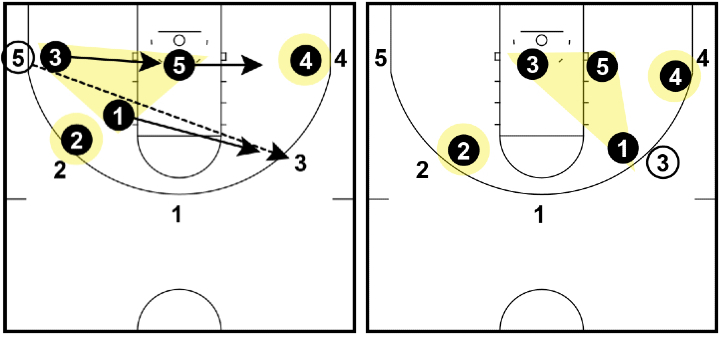
When the ball is skipped from the corner to the opposite wing, the top triangle zone defender will close out and defend if the ball is above the free throw line.
The bottom zone defender will close out and defend if the ball is below the free throw line.
Top to Corner
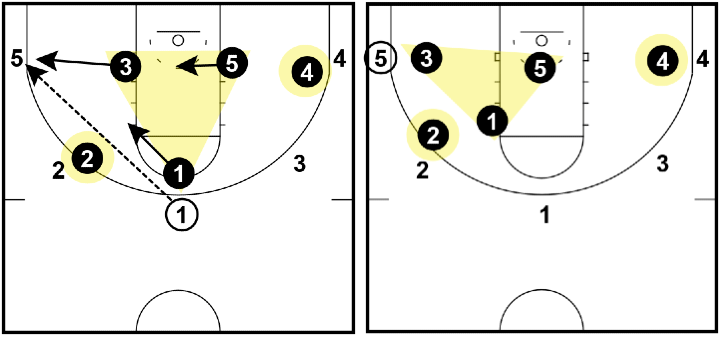
If there is a skip pass from the top of the key to the corner, the bottom triangle zone defender on the ball side should close out and guard the ball.
Again, he has to close out at an angle that encourages the offensive player to drive to the middle, where there will be help defense.
Conclusion
Although the Triangle and 2 is not a defense you should adopt and use every game, it will help you prevent your opponent’s two primary scorers from dominating the game.
It can be introduced relatively easily, it can make your opponent’s best players uncomfortable, and most importantly, it will force the other team to make some type of adjustment.
If you find yourself in the right situation, it can be a great defense to use.
